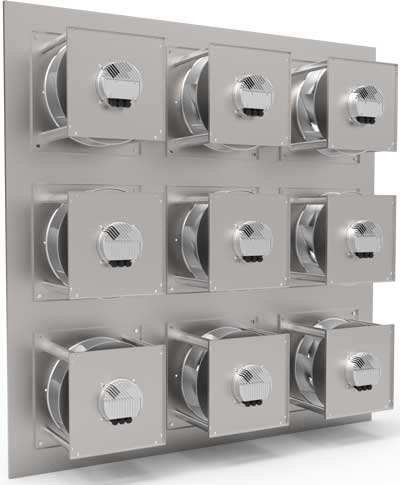Continuous and consistent airflow is essential to virtually every commercial facility, making under-performing or unreliable fans simply unacceptable. In addition to reliability concerns, inefficient fans can be a building’s biggest energy consumer. Given today’s economy and the increasing cause for environmental concern, designers should look to select EC plug fans which will not only provide the necessary reliability, but also provide optimum efficiency and flexibility. In most fan systems, a single fan is selected for the required system and various methods of control are also installed to meet other operating points defined by the system duty such as dampers or variable pitch blades.

In some instances, it is advantageous to use more than one fan in a system, for example when it is necessary for the required operating range of the system to include multiple plug fans running closer to their peak efficiencies, instead of one large fan controlled over a wide operating range. Multiple fans for capacity control may be more economical in a commercial setting if the cost of operation is critical.
Working with supply partner Rosenberg, Axair Fans have developed an energy efficient solution to refurbishing old and outdated ventilation systems such as air handling units with an ECFanGrid.
An ECFanGrid consists of several modular backward curved centrifugal fans or plug fans arranged in a grid construction offering numerous advantages over conventional technology and is equally suitable for new and existing ventilation systems. In addition to being compact and flexible, the ECFanGrid is easy to clean, replace and maintain while expelling low noise and delivering uniform air stream. A uniform air stream improves the efficiency of other downstream components, for example, a thermal wheel.
The Importance of Redundancy
Running fans in parallel allows for redundancy which is designed to improve reliability and consistency. For example, if one fan fails within the fan grid only that portion of the airflow is lost, unlike single fan systems where the entire air handler goes offline. Moreover, the loss of airflow from one plug fan can be offset by increasing the speed of the remaining fans; this can be achieved automatically in conjunction with the building’s management system.
The number of plug fans in each ECFanGrid system can vary according to the airflow requirements. For example, in a wall of 9 fans in a 3×3 configuration where only 7 fans may be required for normal operations to deliver the designed duty, the 8th and 9th space can be blanked off with a plate. If the demands on the AHU increase through building expansion for example, the blanking plates can be removed and 1 or 2 fans added to the grid to meet the new requirements.
Meeting Commercial Demands and Expansion
Unlike a traditional belt drive unit which covers a large floor space, the ECFanGrid is completely free of the floor. This means that maintaining the hygiene of the AHU is quicker, simpler and more effective. No dust is released into the supply air as there are no belt drives to degenerate over time. Furthermore, component failure is quickly dealt with due to the modular nature of the ECFanGrid. For example, a single fan module could be replaced and the AHU back online within an hour of being shut down.
Fan Grids are ideally suited for retrofit AHU projects, particularly where a single large radial fan is being replaced. It is often the case that buildings have expanded around an AHU over its years of operation. This can make the extraction of the old fan problematic but the install of the new fan impossible without minor works to the fabric of the building. Plug fans can be walked through standard pedestrian doorways by no more than two operatives: a significant factor in maintaining a tight replacement schedule, reducing costs and downtime.
Case studies show that there is the potential to significantly lower noise when using an ECFanGrid. There are two major advantages to attenuate noise. First, the noise spectrum of smaller impellers contains higher frequencies, thus the wave lengths are shorter, allowing for the use of shorter attenuators. Second, the required length of the fan section in a typical air handling unit using a single large radial fan can be reduced dramatically, in some cases up to 50%.
For more information, please contact Axair’s team:
www.axair-fans.co.uk
sales@axair-fans.co.uk
Tel: 01782 349430

